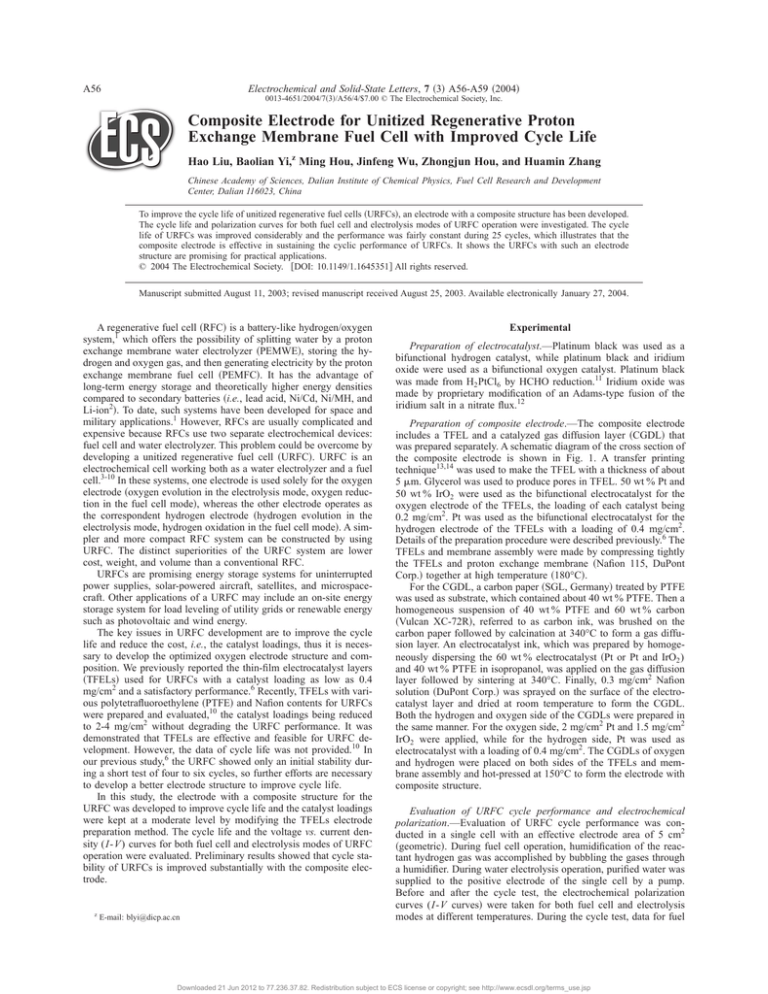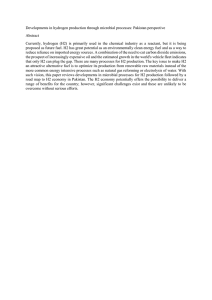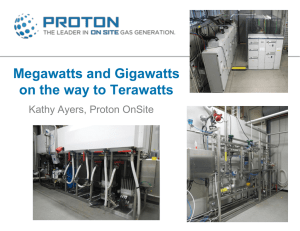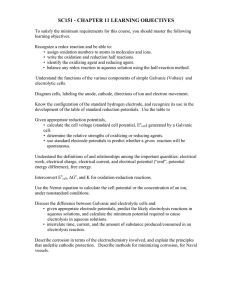
Electrochemical and Solid-State Letters, 7 共3兲 A56-A59 共2004兲
A56
0013-4651/2004/7共3兲/A56/4/$7.00 © The Electrochemical Society, Inc.
Composite Electrode for Unitized Regenerative Proton
Exchange Membrane Fuel Cell with Improved Cycle Life
Hao Liu, Baolian Yi,z Ming Hou, Jinfeng Wu, Zhongjun Hou, and Huamin Zhang
Chinese Academy of Sciences, Dalian Institute of Chemical Physics, Fuel Cell Research and Development
Center, Dalian 116023, China
To improve the cycle life of unitized regenerative fuel cells 共URFCs兲, an electrode with a composite structure has been developed.
The cycle life and polarization curves for both fuel cell and electrolysis modes of URFC operation were investigated. The cycle
life of URFCs was improved considerably and the performance was fairly constant during 25 cycles, which illustrates that the
composite electrode is effective in sustaining the cyclic performance of URFCs. It shows the URFCs with such an electrode
structure are promising for practical applications.
© 2004 The Electrochemical Society. 关DOI: 10.1149/1.1645351兴 All rights reserved.
Manuscript submitted August 11, 2003; revised manuscript received August 25, 2003. Available electronically January 27, 2004.
A regenerative fuel cell 共RFC兲 is a battery-like hydrogen/oxygen
system,1 which offers the possibility of splitting water by a proton
exchange membrane water electrolyzer 共PEMWE兲, storing the hydrogen and oxygen gas, and then generating electricity by the proton
exchange membrane fuel cell 共PEMFC兲. It has the advantage of
long-term energy storage and theoretically higher energy densities
compared to secondary batteries 共i.e., lead acid, Ni/Cd, Ni/MH, and
Li-ion2兲. To date, such systems have been developed for space and
military applications.1 However, RFCs are usually complicated and
expensive because RFCs use two separate electrochemical devices:
fuel cell and water electrolyzer. This problem could be overcome by
developing a unitized regenerative fuel cell 共URFC兲. URFC is an
electrochemical cell working both as a water electrolyzer and a fuel
cell.3-10 In these systems, one electrode is used solely for the oxygen
electrode 共oxygen evolution in the electrolysis mode, oxygen reduction in the fuel cell mode兲, whereas the other electrode operates as
the correspondent hydrogen electrode 共hydrogen evolution in the
electrolysis mode, hydrogen oxidation in the fuel cell mode兲. A simpler and more compact RFC system can be constructed by using
URFC. The distinct superiorities of the URFC system are lower
cost, weight, and volume than a conventional RFC.
URFCs are promising energy storage systems for uninterrupted
power supplies, solar-powered aircraft, satellites, and microspacecraft. Other applications of a URFC may include an on-site energy
storage system for load leveling of utility grids or renewable energy
such as photovoltaic and wind energy.
The key issues in URFC development are to improve the cycle
life and reduce the cost, i.e., the catalyst loadings, thus it is necessary to develop the optimized oxygen electrode structure and composition. We previously reported the thin-film electrocatalyst layers
共TFELs兲 used for URFCs with a catalyst loading as low as 0.4
mg/cm2 and a satisfactory performance.6 Recently, TFELs with various polytetrafluoroethylene 共PTFE兲 and Nafion contents for URFCs
were prepared and evaluated,10 the catalyst loadings being reduced
to 2-4 mg/cm2 without degrading the URFC performance. It was
demonstrated that TFELs are effective and feasible for URFC development. However, the data of cycle life was not provided.10 In
our previous study,6 the URFC showed only an initial stability during a short test of four to six cycles, so further efforts are necessary
to develop a better electrode structure to improve cycle life.
In this study, the electrode with a composite structure for the
URFC was developed to improve cycle life and the catalyst loadings
were kept at a moderate level by modifying the TFELs electrode
preparation method. The cycle life and the voltage vs. current density (I-V) curves for both fuel cell and electrolysis modes of URFC
operation were evaluated. Preliminary results showed that cycle stability of URFCs is improved substantially with the composite electrode.
z
E-mail: blyi@dicp.ac.cn
Experimental
Preparation of electrocatalyst.—Platinum black was used as a
bifunctional hydrogen catalyst, while platinum black and iridium
oxide were used as a bifunctional oxygen catalyst. Platinum black
was made from H2 PtCl6 by HCHO reduction.11 Iridium oxide was
made by proprietary modification of an Adams-type fusion of the
iridium salt in a nitrate flux.12
Preparation of composite electrode.—The composite electrode
includes a TFEL and a catalyzed gas diffusion layer 共CGDL兲 that
was prepared separately. A schematic diagram of the cross section of
the composite electrode is shown in Fig. 1. A transfer printing
technique13,14 was used to make the TFEL with a thickness of about
5 m. Glycerol was used to produce pores in TFEL. 50 wt % Pt and
50 wt % IrO2 were used as the bifunctional electrocatalyst for the
oxygen electrode of the TFELs, the loading of each catalyst being
0.2 mg/cm2. Pt was used as the bifunctional electrocatalyst for the
hydrogen electrode of the TFELs with a loading of 0.4 mg/cm2.
Details of the preparation procedure were described previously.6 The
TFELs and membrane assembly were made by compressing tightly
the TFELs and proton exchange membrane 共Nafion 115, DuPont
Corp.兲 together at high temperature 共180°C兲.
For the CGDL, a carbon paper 共SGL, Germany兲 treated by PTFE
was used as substrate, which contained about 40 wt % PTFE. Then a
homogeneous suspension of 40 wt % PTFE and 60 wt % carbon
共Vulcan XC-72R兲, referred to as carbon ink, was brushed on the
carbon paper followed by calcination at 340°C to form a gas diffusion layer. An electrocatalyst ink, which was prepared by homogeneously dispersing the 60 wt % electrocatalyst 共Pt or Pt and IrO2 )
and 40 wt % PTFE in isopropanol, was applied on the gas diffusion
layer followed by sintering at 340°C. Finally, 0.3 mg/cm2 Nafion
solution 共DuPont Corp.兲 was sprayed on the surface of the electrocatalyst layer and dried at room temperature to form the CGDL.
Both the hydrogen and oxygen side of the CGDLs were prepared in
the same manner. For the oxygen side, 2 mg/cm2 Pt and 1.5 mg/cm2
IrO2 were applied, while for the hydrogen side, Pt was used as
electrocatalyst with a loading of 0.4 mg/cm2. The CGDLs of oxygen
and hydrogen were placed on both sides of the TFELs and membrane assembly and hot-pressed at 150°C to form the electrode with
composite structure.
Evaluation of URFC cycle performance and electrochemical
polarization.—Evaluation of URFC cycle performance was conducted in a single cell with an effective electrode area of 5 cm2
共geometric兲. During fuel cell operation, humidification of the reactant hydrogen gas was accomplished by bubbling the gases through
a humidifier. During water electrolysis operation, purified water was
supplied to the positive electrode of the single cell by a pump.
Before and after the cycle test, the electrochemical polarization
curves (I-V curves兲 were taken for both fuel cell and electrolysis
modes at different temperatures. During the cycle test, data for fuel
Downloaded 21 Jun 2012 to 77.236.37.82. Redistribution subject to ECS license or copyright; see http://www.ecsdl.org/terms_use.jsp
Electrochemical and Solid-State Letters, 7 共3兲 A56-A59 共2004兲
A57
Figure 2. Electrolysis and fuel cell behavior of the URFC during 18th cycle;
Nafion 115 membrane.
Figure 1. Schematic illustration of the cross section of the composite electrode: 共a兲 CGDL consisting of 共a1兲 gas diffusion layer and 共a2兲 electrocatalyst layer; 共b兲 TFEL; 共c兲 proton exchange membrane.
cell operation mode were collected first, and then the cell was run at
electrolysis mode. After data collection in that mode, the cell was
operated as a fuel cell again. The cycle of fuel cell-electrolysis was
then repeated continuously. Generally, the period for fuel cell mode
was 2 h and for electrolysis mode, it was 1 h.
To verify the cyclic performance of URFC and to meet the requirements of the possible rigorous conditions in practical applications, the temperature was strictly controlled. During fuel cell operation, the single cell was operated at 40°C on H2 /O2 with anode/
cathode pressures of 0.4/0.4 MPa. The temperature of hydrogen
humidification was 50°C. During water electrolysis operation, the
cell and water reservoir were kept at ambient temperature 共about
20°C兲 with atmospheric pressure. During fuel cell mode, the I-V
polarization curves were collected at the beginning and the end, and
the fuel cell was run at 400 mA/cm2 during the interval. For electrolysis mode, the current density of electrolysis was fixed as 320
mA/cm2 during the overall running period.
It can be seen from Fig. 2 that the URFC has a lower voltage of
electrolysis even in such a low temperature and a high current density of electrolysis. The average voltage of electrolysis is 1.822 V.
The terminal voltages of electrolysis during 25 cycles are shown
Fig. 3. These results show that the URFC has a good performance
for electrolysis mode. The fuel cell performance at 40°C is important in the context of URFC engineering. Higher temperatures are
typically employed in URFC because of the performance advantages, but the significant simplifications in component and system
design would be possible if the temperature requirement could be
relaxed. Figure 3 also illustrates the performances of the fuel cell
operated at 40°C during the cyclic test. The average terminal voltage
of the fuel cell was 0.723 V at 300 mA/cm2 and 0.645 V at 400
mA/cm2 and it can reach 0.738 V at 300 mA/cm2 and 0.665 V at 400
mA/cm2, which is promising for practical applications.
It can be seen from Fig. 2 that the cell voltages were stable
during the longer test time on both modes of electrolysis and fuel
cell in one cycle test. In Fig. 3, the URFC performance was fairly
constant for both running modes during 25 cycles. These results
show that the cyclic performance of URFC was improved considerably over the one reported previously.6 The stable cyclic perfor-
Results and Discussion
Typical URFC terminal voltage for electrolysis and fuel cell during a cycle are shown in Fig. 2, which was measured in the 18th
cycle. The cyclic performance of URFC is illustrated in Fig. 3. Figure 4 shows the electrolysis voltage vs. current density curves of
URFC at different temperatures before and after cycle test. The
change for the fuel cell performance during different cycles is demonstrated by the I-V curves in Fig. 5.
Figure 3. Performances of fuel cell/electrolysis of URFC as a function of
number of cycles; Nafion 115 membrane.
Downloaded 21 Jun 2012 to 77.236.37.82. Redistribution subject to ECS license or copyright; see http://www.ecsdl.org/terms_use.jsp
A58
Electrochemical and Solid-State Letters, 7 共3兲 A56-A59 共2004兲
Figure 4. Voltage of electrolysis vs. current density curves of URFC at
different temperatures before and after cycle test; Nafion 115 membrane.
mance of URFC is related to the suitable structure of electrode.
There are different requirements operated at different modes. The
requirements for electrolysis application are as follows: the electrode must be corrosion resistant, the electrocatalytic activity for
oxygen evolution reaction must be high,4,9 and the electrode structure must be sufficiently porous to allow fluid transport 共reactant
(H2 O) and products (O2 ,H2 )). At the same time, the mechanical
stability and electronic conductivity must be preserved. The ideal
electrode structure for PEMFC must satisfy three criteria to contribute to the electrochemical reaction in a fuel cell. The criteria are
proton access, gas access, and electronic path continuity.15-20 For gas
access, PTFE is needed because it can facilitate gas diffusion by
providing hydrophobicity to the pore to prevent it from being
clogged with water.
In the composite electrode, the TFELs and the CGDLs are assuming different functions for the electrolysis and fuel cell operation, respectively. The main role of the TFELs is to work at the
electrolysis mode. The TFELs were prepared to be fully hydrophilic
without PTFE, because it has been shown that the water electrolysis
performance scarcely depended on the PTFE content in the
TFELs.10 Furthermore, the hydrophilic TFEL provides a good adhesion between it and the membrane,6,13 which is extremely important
for the cycle life of URFC because the electrodes must sustain high
mechanical tension during gas evolution. Much attention has been
devoted to strengthen the bonding of the electrode onto the
membrane.21-23 The TEFLs and membrane assembly met the somewhat severe requirements in the present study. The TFELs in this
Figure 5. Performances of fuel cell of URFC during different cycles; Nafion
115 membrane.
work provide a sufficient amount of pores for reactant and product
transport, so a satisfactory performance could be achieved with electrocatalyst loadings as low as 0.4 mg/cm2.
According to our previous study,6 it has been shown that electrolysis performance was fairly constant but the fuel cell performance decreased in the cycle test. The main reason was that the
electrodes were flooded, especially on the cathode side, which severely blocked gas access to the three-phase active area. Compared
to electrolysis mode, opposite water management is required for fuel
cell operation, i.e., appropriate hydrophobicity is required during
fuel cell mode. Therefore, the CGDLs, which were fabricated by the
conventional preparation technology of hydrophobic electrodes for
PEMFC and with the needed functions used in URFC, were devised
to take a major role in the function as fuel cell. In the CGDL, carbon
paper and carbon powder treated by PTFE were utilized as gas diffusion layer. The electrocatalyst layer was treated by PTFE as well.
Thus, both of them are hydrophobic to some extent during the
longer term cycle test. It can provide effective gas pathways for
URFC operated at fuel cell mode, particularly for oxygen reduction
reaction.
The stable performance of URFC is related to the roles of TFELs
during fuel cell operation and the ones of CGDLs during electrolysis
operation as well. During the fuel cell reaction, hydrogen ion could
reach favorably the electrocatalyst layers of CGDL because the
TFEL was very thin and there was enough Nafion to conduct H⫹, so
it was not detrimental to the fuel cell performance. Despite the hydrophilicity of the TFEL, the permeability of oxygen through the
TFEL is sufficient such that a 5 m diffusion pathway through the
ionomer to the catalyst particles will not introduce significant oxygen transport losses,24 so TFEL could be considered as the extension
of CGDL in fuel cell operation.
Meanwhile, in the electrolysis mode, water and O2 , H2 products
could diffuse effectively because there were sufficient pores in both
the gas diffusion layer and the electrocatalyst layer of CGDL, so the
performance of electrolysis would not be affected by the presence of
CGDL.
The porous carbon in the gas diffusion layer of CGDL is a good
current conductor and fluid distributor in PEMFC, but it is not stable
as an anode for oxygen evolution.3,25 From Fig. 4 and 5, it is
indicated that the electrolysis and fuel cell performances after cycle
test are all superior to the ones before cycle test. It is known that
carbon is destroyed mainly during the oxygen evolution process, and
the corrosion of carbon subsequently degrades the fuel cell performance. So it shows that carbon in the composite electrode may well
be protected. A possible explanation is that even though the
intermediates such as OH• radical,26-28 atomic oxygen,26,27 or
HO2 • radical28 produced in TFEL during the electrolysis cannot
combine entirely to O2 , and even desorbed from the active surface
sites of the electrocatalysts, they could form oxygen molecule sufficiently in the bulk electrocatalyst layer of CGDL on the unsupported, stable, and highly active electrocatalysts of Pt and IrO2 .
Thus, the electrocatalyst layer can prevent the intermediates with
strong oxidative reactivity from reaching the gas diffusion layer and
attacking the carbon atoms, causing carbon corrosion. Consequently,
the suitable pore structure, electron conductivity, and hydrophobicity in CGDL were protected and the performance of electrolysis
共also the fuel cell兲 could be retained during the cyclic test. As for the
performance improvement of URFC after cycle test, a possible reason may be that Nafion resin attained better hydration after several
cycles, so the conduction of H⫹ in electrocatalyst layers was improved. From the above discussion, it can be seen that the composite
electrode is a promising way to prepare electrodes for practical application of URFC.
Even though the composite electrode described here is feasible
for improving cycle life for URFC, further work is still necessary to
optimize the two-part construction of the electrode, CGDLs and
TFELs, to obtain better performances.
Downloaded 21 Jun 2012 to 77.236.37.82. Redistribution subject to ECS license or copyright; see http://www.ecsdl.org/terms_use.jsp
Electrochemical and Solid-State Letters, 7 共3兲 A56-A59 共2004兲
Conclusion
A composite electrode was prepared and the performance of the
URFC using such electrode was investigated. The cycle life of
URFC was improved considerably with this novel electrode structure, which kept the performance fairly constant for both modes of
electrolysis and fuel cell over 25 cycles. It implies that the composite electrode is promising for the practical application of URFC.
11.
12.
13.
14.
15.
16.
17.
18.
Dalian Institute of Chemical Physics, the Chinese Academy of Sciences,
assisted in meeting the publication costs of this article.
19.
References
20.
1. R. Baldwin, M. Pham, A. Leonida, J. Mcelroy, and T. Nalette, J. Power Sources,
29, 399 共1990兲.
2. K. Bolwin, J. Power Sources, 40, 307 共1992兲.
3. L. L. Swette, A. B. LaConti, and S. A. McCatty, J. Power Sources, 47, 343 共1994兲.
4. T. Ioroi, N. Kitazawa, K. Yasuda, Y. Yamamoto, and H. Takenaka, J. Electrochem.
Soc., 147, 2018 共2000兲.
5. K. Ledjeff, F. Mahlendorf, V. Peinecke, and A. Heinzel, Electrochim. Acta, 40, 315
共1995兲.
6. Z. Shao, B. Yi, and M. Han, J. Power Sources, 79, 82 共1999兲.
7. H. P. Dhar, J. Appl. Electrochem., 23, 32 共1993兲.
8. F. Mitlitsk, B. Myers, and A. H. Weisberg, Energy Fuels, 12, 56 共1998兲.
9. G. Chen, S. R. Bare, and T. E. Mallouk, J. Electrochem. Soc., 149, A1092 共2002兲.
10. T. Ioroi, K. Yasuda, Z. Siroma, N. Fujiwara, and Y. Miyazaki, J. Power Sources,
112, 583 共2002兲.
21.
22.
23.
24.
25.
26.
27.
28.
A59
J. Giner, J. M. Parry, and S. M. Smith, Fuel Cell System-II, 151 共1969兲.
R. Adams and R. L. Shriner, J. Am. Chem. Soc., 45, 2171 共1923兲.
M. S. Wilson and S. Gottesfeld, J. Appl. Electrochem., 22, 1 共1992兲.
M. S. Wilson and S. Gottesfeld, J. Electrochem. Soc., 139, L28 共1992兲.
M. S. Wilson, J. A. Valerio, and S. Gottesfeld, Electrochim. Acta, 40, 355 共1995兲.
S. Mukerjee, S. Srinivasan, and A. J. Appleby, Electrochim. Acta, 38, 1661 共1993兲.
H.-F. Oetjen, V. M. Schmidt, U. Stimming, and F. Trila, J. Electrochem. Soc., 143,
3838 共1996兲.
T. R. Ralph, G. A. Hards, J. E. Keating, S. A. Campbell, D. P. Wilkinson, M. Daris,
J. St-Pierre, and M. C. Johnson, J. Electrochem. Soc., 144, 3845 共1997兲.
J. S. Wainright, J.-T. Wang, R. F. Savinell, and M. Litt, J. Electrochem. Soc., 142,
L121 共1995兲.
J.-T. Wang, R. F. Savinell, J. Wainright, M. Litt, and H. Yu, Electrochim. Acta, 41,
143 共1996兲.
A. Katayama-Akamata, H. Nakajima, K. Fujikawa, and H. Kita, Electrochim. Acta,
28, 777 共1983兲.
H. Kita, F. Fujikawa, and H. Nakajima, Electrochim. Acta, 29, 1721 共1984兲.
H. Nakajima, Y. Takakuwa, H. Kikuchi, F. Fujikawa, and H. Kita, Electrochim.
Acta, 32, 791 共1987兲.
S. Gottesfeld, I. Raistrick, and S. Srinivasan, J. Electrochem. Soc., 134, 1455
共1987兲.
A. Hamnett, P. S. Stevens, and R. D. Wingate, J. Appl. Electrochem., 21, 982
共1991兲.
K. Darowicki and J. Orlikowski, J. Electrochem. Soc., 146, 663 共1999兲.
G. Chen, X. Chen, and P. L. Yue, J. Phys. Chem. B, 106, 4364 共2002兲.
T. R. Beck and R. W. Moulton, J. Electrochem. Soc., 103, 247 共1956兲.
Downloaded 21 Jun 2012 to 77.236.37.82. Redistribution subject to ECS license or copyright; see http://www.ecsdl.org/terms_use.jsp




